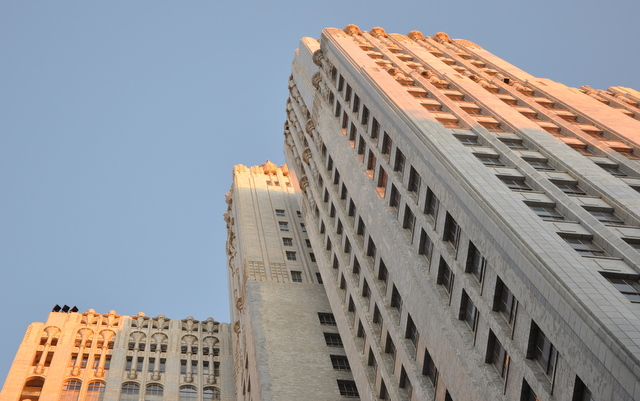The building that stands at 140 New Montgomery was built in 1925 for the Pacific Telephone Company, part of the Bell System. It was, at the time, the first significant skyscraper in San Francisco, as well as the city’s first skyscraper in the Moderne style. According to the San Francisco Newsletter, published in 1925, “The interiors are entirely fireproof and are exceptionally well lighted. Its features include a cafeteria for women employees and an assembly hall seating 400 people.” It was also the first building to be wired so that each desk could have a personal telephone.

Designed by James Rupert Miller and Timothy Pflueger, the Bell Telephone Building is often categorized as both Neo Gothic-a style that borrows details from medieval Gothic architecture-and Art Deco, a style introduced at the 1925 Paris Exhibition that flourished throughout the 1930s and during WWII. Art Deco is based on geometric forms and places an emphasis on sleek appearances, reflecting the modernity of science and industry in the 20th century. The term “Moderne” is the United States Landmarks Commissions’ general term for styles of architecture that were popular from 1925 through the 1940s. It has expression in styles traditionally classified as Art Deco, Streamline Moderne, and WPA Moderne.
 The building is 436 feet high with 26 floors. It is clad in nine different shades of grey granite-like terra cotta. Its original construction cost: $4.55 million dollars.
The building is 436 feet high with 26 floors. It is clad in nine different shades of grey granite-like terra cotta. Its original construction cost: $4.55 million dollars.
Miller and Pflueger were heavily influenced by Eliel Saarinen, winner of the 1922 second-prize design for The Chicago Tribune Tower, a design that was never executed. Saarinen used vertical elements and gradual setbacks in his design, which are characteristics of the Bell Telephone Building. (Set backs are step-like recessions in walls, initially used for structural reasons.)
 In 1926 The San Francisco Examiner called 140 Montgomery “the shimmering gleaming monument to talk.”
In 1926 The San Francisco Examiner called 140 Montgomery “the shimmering gleaming monument to talk.”
The lobby floor is black polished marble. Overhead a red stenciled ceiling features intertwining black and gold designs of unicorns, phoenixes, clouds and odd creatures. All this is complimented by very elaborate elevator doors.
The building’s exterior is a paean to the Bell Phone system. The logo over the main entryway is surrounded by stylistic blue bells, the company’s iconic flower. There are small bells in panels across the facade as well.
In 2007, at the height of the real-estate bubble, the building was purchased with the intent of turning it into high-end condominiums. The subsequent credit crunch has slowed those plans way down. Currently the building sits empty. With the exception of a few night-time trespassing photographers that have blogged about their experience, public entry is not permitted. At present, a glimpse of the lobby can still be had through a walking tour with San Francisco City Guides.
 The building has no Historic Landmark Status meaning it is not recognized by the US government for its historic significance. Because, however, it is categorized by the City of San Francisco as being of “individual importance” and “excellent” in architectural design, it is protected from demolition. The new owners are working closely with numerous preservation boards and organizations responsible for historic building oversight to keep as much of the building intact as possible.
The building has no Historic Landmark Status meaning it is not recognized by the US government for its historic significance. Because, however, it is categorized by the City of San Francisco as being of “individual importance” and “excellent” in architectural design, it is protected from demolition. The new owners are working closely with numerous preservation boards and organizations responsible for historic building oversight to keep as much of the building intact as possible.
For example, bas reliefs depicting a snake charmer, a bear, and other exotic figures on the walls of the assembly hall’s proscenium (the area between the curtain and the orchestra) will be saved. The original Bell logos will be recreated, mounted on hexagon medallions, and placed over each of the elevators in the lobby. Much of the terra cotta will need to be repaired, and every single window frame above the third floor will have to be replaced.
 Flying phone books ornament the exterior of the building.
Flying phone books ornament the exterior of the building.
A large part of the construction process will include seismic retrofitting, which involves the modification of existing structures to make them more resistant to earthquakes. The engineers are concerned mostly with the exterior shell of the building: the terra cotta has not been maintained properly and is in danger of breaking off in pieces and falling. Sadly, when construction is finished, the only way you will be able to see the inside of the building is through a friend who lives there, or an architectural city tour that includes 140 Montgomery in its itinerary.
For a viewing of the lobby of 140 New Montgomery, take the Downtown Deco tour, available at San Francisco City Guides. More information on the development of the building can be found here.







